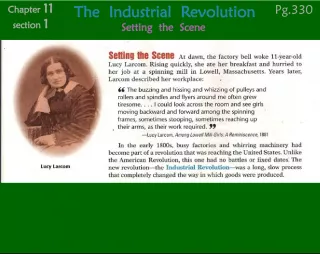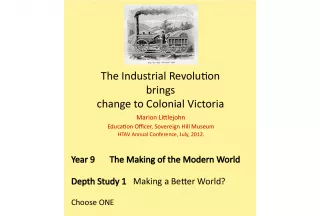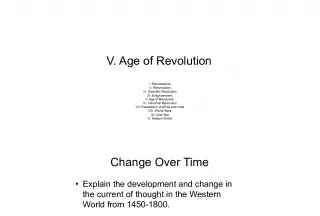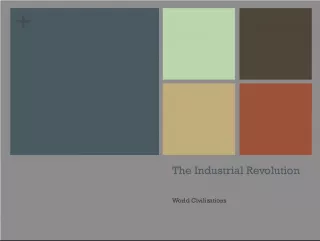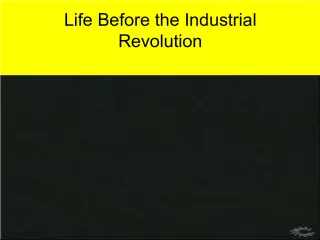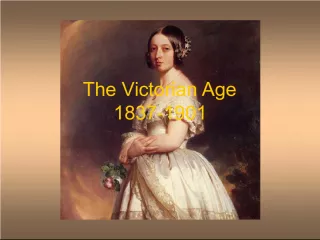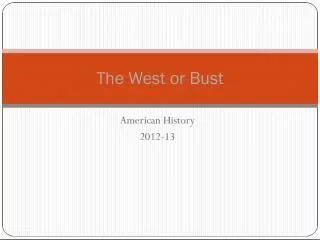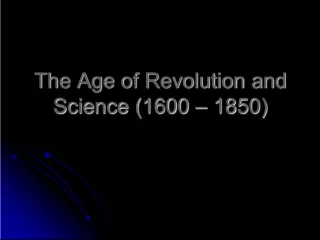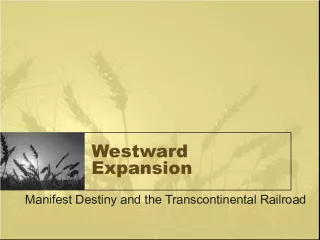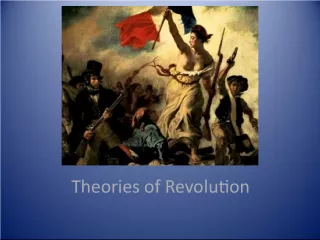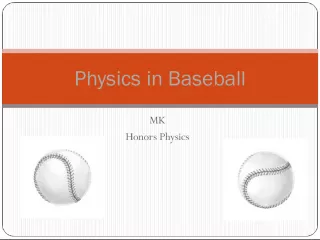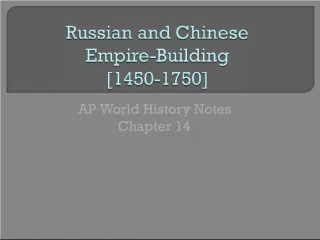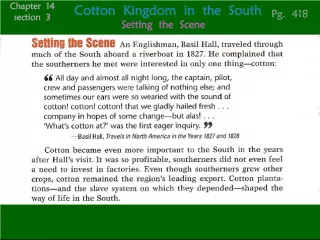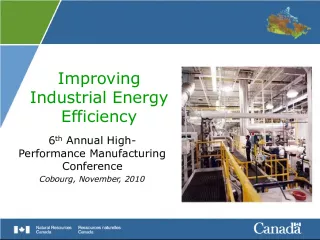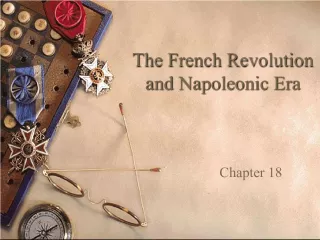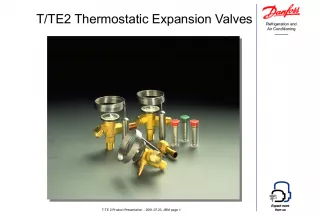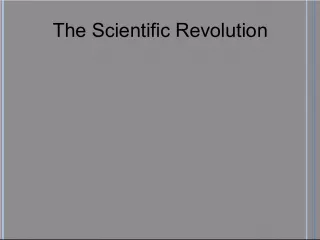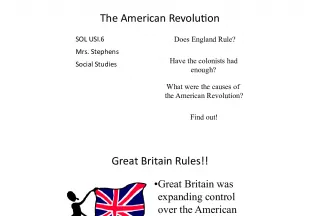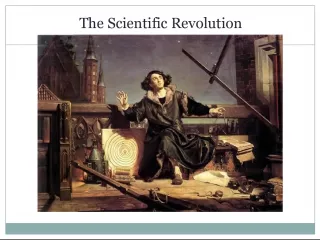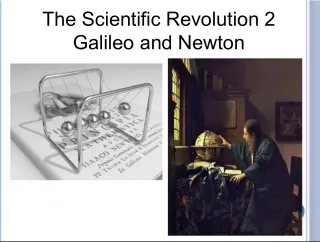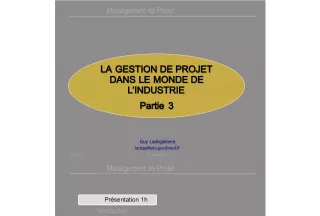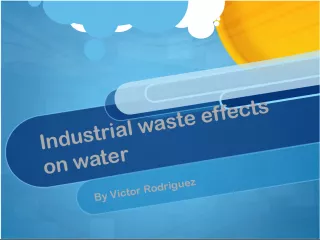The Industrial Revolution and Westward Expansion
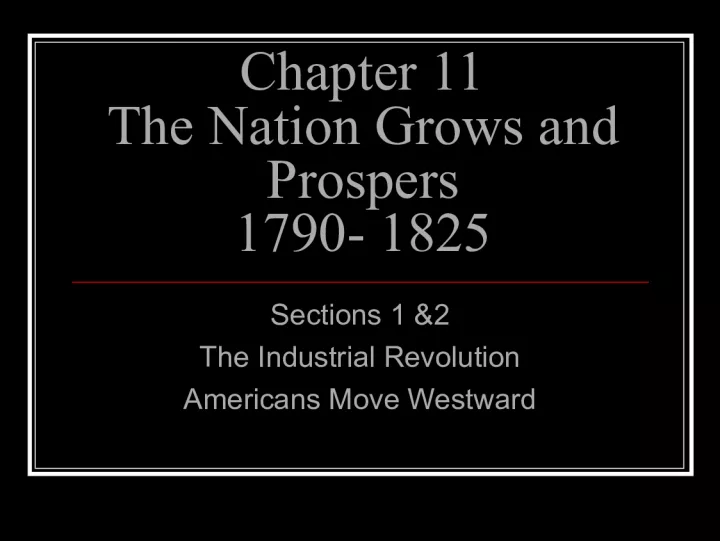

In this chapter, we will explore the Industrial Revolution and its effects on the United States, with a particular focus on early factories in Lowell, Massachusetts. We will also examine how settlers traveled west
- Uploaded on | 6 Views
-
 veselan
veselan
About The Industrial Revolution and Westward Expansion
PowerPoint presentation about 'The Industrial Revolution and Westward Expansion'. This presentation describes the topic on In this chapter, we will explore the Industrial Revolution and its effects on the United States, with a particular focus on early factories in Lowell, Massachusetts. We will also examine how settlers traveled west. The key topics included in this slideshow are . Download this presentation absolutely free.
Presentation Transcript
Slide1Chapter 11The Nation Grows and Prospers 1790- 1825 Sections 1 &2 The Industrial Revolution Americans Move Westward
Slide2Objectives Identify the Industrial Revolution and its effects on the United States Describe early factories with focus on Lowell, Massachusetts Describe how settlers traveled west Explain new developments in transportation
Slide3I. The Industrial RevolutionA. New Technology 1. Begins in Britain mid 1700s 2. New machines for textile industry 3. James Hargreaves invented Spinning jenny – could spin several threads at once 4. Water powered loom – Edmund Cartwright 5. Produced more cloth in a day than was possible before
Slide4Spinning Jenny
Slide5B. The Factory System1. New inventions required new systems of production 2. Capitalist- a person who invests in a business in order to make a profit 3. Factory system- brought workers and machinery together in one place to produce goods
Slide6Spinning JennySlater’s Mill
Slide7II. A Revolution Crosses the AtlanticA. Slater Breaks the Law 1. British law forbid anyone to take plans for new machinery out of the country 2. 1789 Slater left Britain 3. Memorized the plans so he wouldn’t get caught with them B. The First American Mill 1. 1793 Slater built the first successful textile mill in the US powered by water 2. Pawtucket, RI
Slide8C. Interchangeable parts- all machine made parts are identical to each other 1. Eli Whitney 2. Earlier, everything made one at a time 3. Saves time and money 4. Idea spread rapidly
Slide9III. Lowell, Massachusetts: A ModelFactory Town A. Had to produce more goods because of the blockade of ports during War of 1812 B. The Lowell Mills 1. Francis Cabot Lowell 2. Combine spinning and weaving under one roof 3. Built a whole town of factories as a model of efficiency
Slide10Lowell and Lowell Girls
Slide11C. The Lowell Girls1. Young women from nearby farms 2. Most sent wages home 3. Boarding houses 4. Rules 5. Independence
Slide12IV. Daily Life During the IndustrialRevolution A. Child Labor 1. As young as seven 2. Not seen as cruel because farm work was just as hard or harder 3. Child’s wages needed to support the family B. Long Hours 1. 12 hour days, 6 days a week 2. Conditions better than in Europe 3. As competition increases, owners grew less interested in welfare of workers
Slide13C. Changes in Home Life1. More family members left home to earn a living 2. Affected ideas about the role of women 3. Poor women had to work
Slide14V. Growing CitiesA. Many people left farms to work in factories B. Urbanization-movement of population from farms to cities 1. Steady but gradual process 2. Early cities were small but growing
Slide15Pros and Cons of Urban Living C. Hazards 1. Dirt streets turned to mud in rain 2. No sewers, garbage in streets 3. Disease spread easily D. Attractions 1. Theaters, museums, circuses 2. Latest fashions, shopping
Slide16Americans MoveWestward
Slide17VI. Traveling WestA. “West” - referred to the lands between the Appalachians and the Mississippi River B. Population of some of 13 colonies declines as people move west C. Need to improve transportation to the west is obvious
Slide18D. Western Routes1. Great Wagon Road through Pennsylvania 2. Wilderness Road south and west by Daniel Boone’s route, led through Cumberland Gap 3. Flatboats down Ohio River 4. People from GA and SC followed routes to AL and MS 5. People from NE pushed into NW territory
Slide19Flatboats
Slide20New States Enter the UnionE. New States 1792 Kentucky 1796 Tennessee 1803 Ohio 1812 Louisiana 1816 Indiana 1817 Mississippi 1818 Illinois 1819 Alabama
Slide21VII. Improvements to RoadsA. Turnpikes and Corduroy Roads 1. Roads built by private companies 2. Turnpikes for tolls 3. Lancaster Turnpike the best of its time, linked Lancaster and Philadelphia 4.Corduroy roads of logs 5. Covered bridges lasted longer than plain wood
Slide22 B. The National Road 1. 1806 Congress sets aside funds 2. Road to run from Cumberland, Maryland to Wheeling in western VA 3. Work begins 1811 and is completed in 1818 4. Road later extended as needed
Slide23VIII. Steam TransportA. Fitch and Fulton 1. Fitch showed how a steam engine could power a boat (Constitutional Convention 1787) 2. Few people used his ferry service 3. Fulton launched a steamboat - the Clermont on the Hudson River 4. 300 mile trip in 62 hours - record
Slide24What would be some of theadvantages of the steamships? B. The Age of Steamboats 1. Revolutionized travel in the west 2. Gave farmers and merchants a cheap way to move goods 3. Dangerous at times as sparks can explode high pressure boilers
Slide25IX. The Canal BoomA. Building the Erie Canal 1. Let farmers ship goods to port of New York 2. Links Great Lakes with Hudson River 3. DeWitt Clinton , governor of NY, instrumental in getting it built 4. “Clinton’s Ditch”
Slide27The Big Ditch This painting shows the "Seneca Chief," the flagship of a flotilla making the maiden voyage down the Erie Canal. The 363-mile-long, $7 million canal opened the shortest thoroughfare between the Atlantic Coast's factories and the natural bounty of the Great Lakes, helping to position New York City as America's leading metropolis. The Canal did not greatly affect business for stagecoach companies, which were faster, and not limited by road capacity or ice, but it did bankrupt the Conestoga wagon freight carriers. By 1841, however, the railroads had put stagecoach companies out of business. The Erie Canal still operates today.
Slide28The Erie Canal I've got a mule, Her name is Sal, Fifteen years on the Erie Canal. She's a good old worker And a good old pal, Fifteen years on the Erie Canal. We've hauled some barges in our day Filled with lumber, coal and hay And ev'ry inch of the way I know From Albany to Buffalo. Low Bridge, ev'rybody down, For it's Low Bridge, We're coming to a town! You can always tell your neighbor, You can always tell your pal, If you've ever navigated On the Erie Canal. Low Bridge, ev'rybody down, For it's Low Bridge, We're coming to a town! You can always tell your neighbor, You can always tell your pal, If you've ever navigated On the Erie Canal. We better get along On our way, old gal, Fifteen miles on the Erie Canal. Cause you bet your life I'd never part with Sal, Fifteen miles on the Erie Canal. Git up there, mule, here comes a lock, We'll make Rome 'bout six o'clock. One more trip and back we'll go Right back home to Buffalo. Low Bridge, ev'rybody down, For it's Low Bridge, We're coming to a town! You can always tell your neighbor, You can always tell your pal, If you've ever navigated On the Erie Canal. Low Bridge, ev'rybody down, For it's Low Bridge, We're coming to a town! You can always tell your neighbor, You can always tell your pal, If you've ever navigated On the Erie Canal.
Slide29Chapter 11The Nation Grows and Prospers 1790- 1825 Sections 3 & 4 Unity and Division New Nations in the Americas
Slide30Objectives Discuss the role played by sectionalism in the Era of Good Feelings Explain how the Latin American nations won independence and became republics Describe how the United States gained Florida from Spain Discuss the purpose of the Monroe Doctrine
Slide31Era of Good Feelings James Monroe : (Republican) easily won the Presidency in 1816. After inauguration, he toured the country and was well received even in New England.
Slide32I. Three Sectional LeadersA. Calhoun of the South 1. John C. Calhoun of South Carolina 2. Supported War of 1812 and slavery 3. Opposed policies that would strengthen the power of the federal government
Slide33B. Daniel Webster of theNorth 1. New Hampshire 2. Most skillful public speakers 3. Opposed War of 1812 and slavery 4. Wanted government to take a larger role in building the nation’s economy
Slide34C. Henry Clay of theWest 1. Leader of War Hawks in War of 1812 2. VA- KY 3. Favored a more active role for central government in promoting the country’s growth
Slide35National BankThe National Bank was re-chartered in 1816. Americans wanted a central bank to loan money.
Slide36Flood of British Goods After the War of 1812 the American Market was flooded with cheaper British Goods This threatened the new Industrial USA.
Slide37Congress Passes Protective Tariff To even the playing field with Great Britain, the US congress passed the Protective Tariff.
Slide38The American SystemD. Sectionalism – loyalty to one’s state or section rather than to the country as a whole E. Internal improvements – improvements for roads, bridges, and canals
Slide39Henry Clay’s American System Clay wanted economic growth for regions of the country. High taxes on imports= more $ for north to buy southern and western goods.
Slide40American System: Definition What is Henry Clay’s American System ? “the policy of promoting industry in the U.S. by adoption of a high protective tariff and of developing internal improvements by the federal government (as advocated by Henry Clay from 1816 to 1828)” House Speaker, Henry Clay coined the term “ American System ” in 1815, after President Madison created a plan to unite the Northern and Southern economies.
Slide41North Economy: +/- Northern Economy : Strengths 1. The north had just experienced an Industrial Revolution , and was producing manufactured goods. 2. New methods of transportation that brought goods to and from the manufacturing north. 3. A new, national currency that enabled the north to trade with the south and west. Northern Economy : Weaknesses 1. Poor soil, low crop production, few livestock.
Slide42Southern/Western Economy: +/- Southern/Western Economy : Strengths 1. Good and rich soil for plantation farming. 2. Increased slavery, increased productivity. 3. Use of the Mississippi River for transportation of goods between the north and south economies. • Southern/Western Economy : Weaknesses 1. No factories for manufacturing goods. 2. Heavy, intense labor needed to run the plantations smoothly in the south.
Slide43The Supreme Court ExpandsFederal Power Chief Justice John Marshall Under John Marshall, the Supreme Court would increase the power of the Federal governement.
Slide44McCulloch v. MarylandIn 1819, Maryland levied heavy taxes on a local branch of the National Bank to make it fail. It was declared unconstitutional.
Slide45Gibbons v. Ogden Interstate Trade- trade between different states. This case upheld the federal governments right to regulate trade between states.
Slide46New Nations in theAmericas
Slide47Revolution in Latin America By 1810 the people of the Spanish American colonies were eager for independence.
Slide48Mexican Independence 1821 Mexican independence gained. The leaders Hidalgo and Morelos were killed. Even creoles -Latin born people of Spanish parents, joined the fight
Slide49The Liberator A Venezuelan creole Lead attack that defeated Spanish forces in 1819 Became President of Rep. of Great Columbia -Venezuela, Columbia, Ecuador, Panama
Slide50Other New Nations In 1821 the people of Central American formed the United Provinces of Central American Nicaragua, Costa Rica, El Salvador, Honduras, and Guatemala
Slide51The US gains Florida Since the 1700s Spain protected runaway slaves. Seminole Indians shared their lands Andrew Jackson ordered the fort to be destroyed.
Slide52The US gains Florida1818 Jackson returns to FL with 3,000 soldiers Spain cannot risk war with U. S, Spain agreed to give U. S. Florida in exchange for 5 million dollars
Slide53The United States Gains Florida Adams-Onis Treaty- an agreement between the US and Spain in which Spain gave all it claims in Florida up to the US.
Slide55III. Monroe Doctrine - 1832A. United States would not interfere in the affairs of European nations or existing colonies of the European nations B. European nations are not to attempt to gain control of the new independent nations of Latin America
Slide56Monroe DoctrineC. Stated that the U.S. would oppose any attempt to build new colonies in the Americas D. Showed that the U.S. is determined to keep European powers out of the Western Hemisphere E. England supported Monroe Doctrine with its navy F. Has shaped U. S. foreign policy even now
